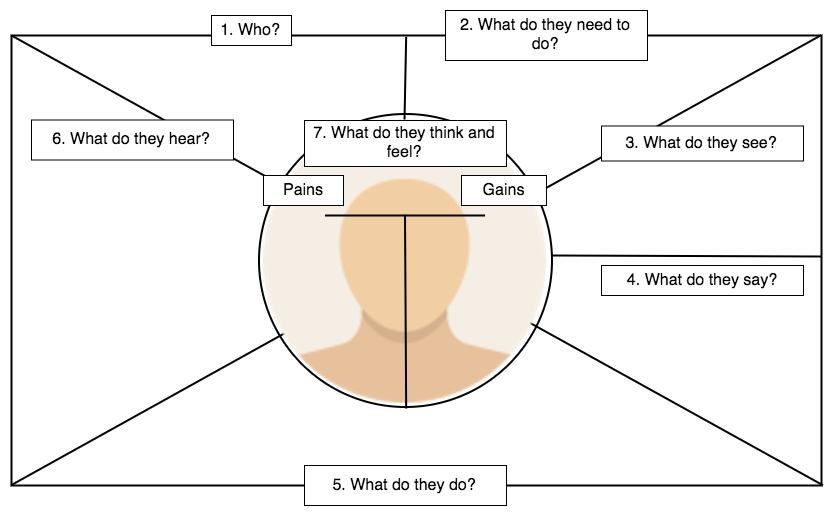In a previous post, I discussed the importance of Empathy Mapping and why cultivating empathy, both in ourselves as educators and in our students, is essential. In this article, I want to revisit the concept of empathy mapping and explore how incorporating AI prompts can streamline the process, making it easier to create empathy maps and derive meaningful conclusions from them.
To recap, Empathy Mapping is a versatile tool designed to help individuals or groups gain deeper insights into the thoughts, emotions, motivations, and needs of others. Originally developed by marketing and product development teams to better understand their customers, empathy mapping has proven to be equally valuable in education. For teachers and trainers, it offers a structured way to better comprehend the needs and motivations of students, as well as the external factors that influence them. It can also be a powerful exercise for students, enabling them to build empathy and a deeper understanding of others’ perspectives.
The process of creating an empathy map can be done individually or with a group and the key to it is a set of 7 key questions that you use to focus your attention on the subject of the empathy map.
These questions are:
- What does the person say? – What are they saying aloud? This could include direct quotes, opinions, or feedback shared during interviews or observations.
- What does the person think? – What might they be thinking but not saying? Consider their internal thoughts, worries, aspirations, or unspoken concerns.
- What does the person do? – What actions or behaviours are they exhibiting? Observe how they interact with their environment and the other people around them.
- What does the person feel? – What emotions are they experiencing? Identify their frustrations, joys, fears, or motivations.
- What does the person hear? – What external influences impact them? Consider the messages, advice, or pressures they hear from colleagues, friends, family, or society.
- What are the person’s pain points? – What challenges or obstacles are they facing? Identify the barriers preventing them from achieving their goals.
- What does the person hope to gain? – What are their goals or desired outcomes? Understand their needs, aspirations, or what success looks like to them.
How AI can help
Recently I’ve found that using an interactive AI prompt to guide this process can be really beneficial as it helps to focus on each stage of the process as you work through it, and it can then provide a summary and help you draw conclusions about how and what you can do to help the subject or the empathy map. In this way, it takes us through understanding the person to finding practical ways we can help them.
Empathy mapping prompt
This is the first prompt that you’ll need. Before using this prompt, decide who it is you want to focus on. Once you enter the prompt, the AI will start asking you questions. As you answer each question, the AI will move you to the next one, and then at the end of the process it will create a summary of your answers. Once you have the summary, you can use the follow-up prompt to get suggestions for action you can take to help the person.
Interactive prompt
“Please walk me through the stages of creating an empathy map. Do this by asking me questions and waiting for my response before asking the next question. Once you have gathered all the information you need from me, help me produce the empathy map. If you understand, start by asking me the first question.“
Follow up prompt
“Use the information from this empathy map to suggest ways I can help and support this person.“
Having these prompts can be especially useful if you want to get students working through this process. The AI will act as a guide for them and structure the process so that they don’t get lost or confused. It will also help them to draw a conclusion from the process, and they’ll be able to discuss and evaluate the AI generated suggestions.
When you finish the process of empathy mapping, it’s good to encourage students to reflect on what they have learned from it and whether they feel they understand the person better.

Here are some activities you can use empathy mapping for:
Empath mapping for teachers
- Create a general empathy map for a class you are teaching
Reflect on your class as a whole and use the empathy mapping process to understand their collective experiences. Consider what your students might be saying during class discussions, thinking about the material, and feeling about their learning environment. Analyse their behaviours in group activities or individual work and identify external factors, such as cultural backgrounds or pressures from home, that might influence them. This can help you adjust your teaching methods, improve lesson engagement, and address any barriers to learning. - Select a specific student who is struggling or who you are struggling with
Focus on an individual student who might be facing challenges or with whom you find it difficult to connect. Use empathy mapping to understand what they might be verbalising (e.g., complaints, questions), thinking but not saying (e.g., anxieties, insecurities), or feeling about their learning experience. Observe their behaviours, such as participation levels or body language, and consider what external factors might be impacting them (e.g., family pressures, peer influences). This can provide insights into how you can better support their needs or address any communication barriers. - Create an empathy map for a colleague that you have some difficulties with
Empathy mapping can also help improve professional relationships. Focus on a colleague with whom you have tension or misunderstandings. Think about what they might express openly during conversations, their potential unspoken concerns or motivations, and how their behaviour reflects their feelings. Consider external pressures they might be facing, such as workload, personal circumstances, or administrative expectations. By better understanding their perspective, you can identify ways to collaborate more effectively or find solutions to ease tensions.
Empathy mapping with students
- Focus on someone with very different views to their own.
Have students identify a real or hypothetical person whose beliefs, values, or opinions contrast significantly with their own. This could be a historical figure, a political leader, or even a classmate. Ask them to create an empathy map for this person by considering their thoughts, feelings, and motivations. Encourage students to reflect on how this person’s background or experiences might have shaped their perspectives. This activity can help students develop empathy for differing viewpoints and foster open-mindedness. - Focus on a character in an image from their course book.
Choose an image from the course book, such as one depicting a scene or interaction between people. Ask students to choose one character in the image and create an empathy map for them. Students should use visual clues such as expressions, body language, and the setting to infer the character’s thoughts, feelings, and motivations. This activity is particularly useful for developing observation and inference skills, as well as sparking creative discussions about the character’s context and emotions. - Choose a character from a story they are reading or a film they like (it can be interesting to pick a villain or someone they don’t like).
Encourage students to select a character from a story or film they are familiar with. While they can choose a hero, focusing on a villain or an unlikeable character often leads to richer insights. Ask students to delve into the character’s backstory, considering what might drive their actions and decisions. This helps students understand complex motivations and challenges their initial judgments about the character, promoting deeper critical thinking and empathy. - Ask them to create an empathy map to empathise with you (if you are feeling brave).
Invite students to create an empathy map for you, their teacher. Share a brief personal scenario or challenge you face as a teacher (appropriate for their level and context). Guide them to consider what you might be thinking, feeling, and experiencing. This activity not only helps students practice empathy but also strengthens the teacher-student relationship by fostering mutual understanding. - Ask them to create an empathy map for someone they have a difficult relationship with.
Have students identify a person with whom they have a strained or challenging relationship. This could be a friend, family member, or classmate. Encourage them to create an empathy map to explore this person’s potential thoughts, feelings, and motivations. The activity helps students step into the other person’s shoes, fostering understanding and potentially opening the door to improved communication and resolution.
I hope you can see from this article that empathy mapping is a powerful tool for fostering deeper understanding and connection, both in educational settings and beyond. By using AI prompts to guide the process, we can streamline and enhance the experience, making it accessible and structured for both teachers and students. This approach not only helps us identify the needs, thoughts, and emotions of others but also leads to actionable insights that can improve relationships, teaching strategies, and learning outcomes. Whether used to understand a class, support a struggling student, or develop empathy for diverse perspectives, empathy mapping encourages reflection, compassion, and meaningful growth in all participants.
If you want to learn more about this style of collaborative prompting and how it can support your development as a teacher, then check out my course ‘Developing your Teaching with Generative AI‘.


